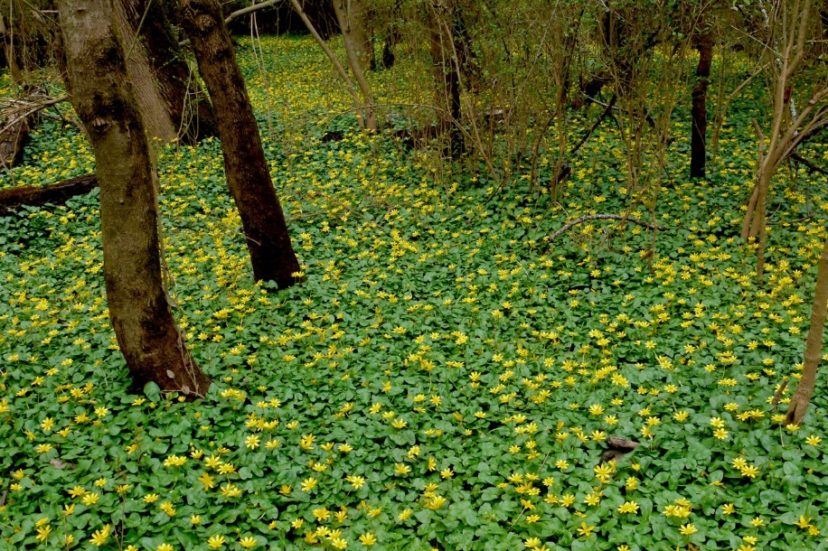
With Richmond, like the rest of Virginia, under a public health emergency Executive Order to “remain at their place of residence”, we’re all getting better acquainted with the places we call home. Fortunately, staying at home doesn’t mean staying inside. And tackling invasive plants is a great way to nurture nature and yourself:
- It’s a satisfying stress reliever; your brain gets a rest while your body gets a workout, and you are rewarded with measurable results.
- Controlling invasive plants is essential for a more ecologically healthy yard; if you want your home to be habitat for more than just you and your family, this is step one.
- You’ll earn the right to dream and plan . . . about planting locally native plants in the fall.
- You’ll be helping out our park system even while the Task Force has to suspend public volunteer events. Making progress in the park means slowing the spread from outside of it.
Even the smallest yard likely harbors invasive plants, so read on for identification and management guidance on a few of the JRPS Invasive Plant Task Force’s “least wanted”, all Virginia state-listed invasive species:
These Vines are Not Fine
Truetimber’s own Mike Mather recently explained how to rescue your trees from the dangerous burden of English ivy, but other invasive vines may lurk in your yard:

- Winter Creeper (Euonymous fortunei) hangs out with English ivy and behaves just as badly; the two dominate in the James River Park System, threatening our city’s tree canopy and carpeting once rich woodlands. Free your trees and pull the ground cover, getting out all the roots as much as possible.
- Japanese Honeysuckle (Lonicera japonica) is the most widespread invasive vine in the eastern United States, smothering native vegetation and girdling to death tree and shrub saplings. Locating and pulling the rooting nodes of this invasive is uniquely satisfying.
- And while you’re at it . . . reconsider that Periwinkle (Vinca major, minor). This still popular landscaping vine is also invasive.
Herbaceous Horrors
As you may have read here, Fig Buttercup (Ficaria verna) is one of the most recent invaders of the park system threatening our indigenous spring ephemerals (wildflowers), but it isn’t spring’s only invasive target.

- Garlic Mustard (Alliaria petiolata), another park invader you may find at home, is easier to remove because it’s a ‘herbaceous forb’, not a vine or woody stemmed plant. Garlic Mustard displaces native spring wildflowers and is toxic to the larvae of our butterfly species whose host plants are natives in the Mustard family.
- This biennial species takes two years to mature; first-year plants are low “rosettes” with kidney shaped, scalloped leaves that become more heart-shaped in their second year when the plant flowers and seeds. Pull these plants, getting the entire tap root, prior to flowering and setting seed. Bag and dispose of any plants that already have flowered. The ideal window for removing Garlic Mustard in our area has just closed, so use caution. For detailed identification and instructions, see this action alert from Blue Ridge PRISM.
Don’t Hedge Your Bets – Get Rid of These Shrubs
The two most dominant invasive shrubs in the James River Park System are Amur Honeysuckle (Lonicera maackii) and Chinese Privet (Ligustrum sinense), both so abundant and successful at suppressing native flora that we see little else in the understory. They are ubiquitous in residential hedges and naturalized areas as well.

- Amur Honeysuckle Don’t be lured by its fragrant blossoms and associated childhood nostalgia — Amur Honeysuckle is a habitat destroyer. Its dense thickets leaf out in February, shading out native vegetation; it is “allelopathic”, generating its own chemical that, depending on soil conditions, acts as herbicide for many native plants; and its berries are the equivalent of junk food, inadequate nourishment for songbirds in need of their native plant food sources.
- Chinese Privet The worst of numerous invasive privet species, Chinese Privet has a lot in common with Amur honeysuckle – a multi-strategy habitat destroyer.
- New seedlings and smaller, young plants of both are easy to pull up with your hands. Repeatedly cutting back larger shrubs prevents their reproduction and spread. Follow the embedded links above for more control and removal guidance.

Next week we’ll shift to a more upbeat topic – native flora treasures hidden in plain sight!
FOR MORE INFORMATION
Virginia Department of Conservation and Recreation’s Natural Heritage Program
Plant Invaders of Mid-Atlantic Natural Areas (National Park Service)


